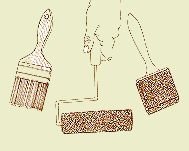
Silica fillers
Microspheres filler
Fiber filler
GLUE APPLICATION METHODS
AS AN ADHESIVE
The viscosity of POXY-GRIP® structural adhesive is such that the addition of fillers is normally not necessary. This product can be used as a glue without modification. lt need be applied to only one of the mating surfaces.
POXY-SHIELD® has a much lower viscosity, formulated to wet out and encapsulate wood. Because of this, some thickening with our fillers is frequently called for when using POXY-SHIELD® as an adhesive. This is especially so with end-grain or edge-grain situations where the unthickened product may be soaked excessively into the wood. Without thickening, the resin will not be able to bridge minor gaps and irregularities, or will drain from the joint and not contact all bonding surfaces evenly. The results can be a glue-starved joint.
In parallel-grained, horizontal applications with well-fitted smooth surfaces (such as in gluing up laminated woodmembers), thickening is really only required for ease of working if the tendency for the resin to drain makes the work messy or inconvenient. Bonds will be excellent without modification in all cases as long as sufficient POXY-SHIELD® remains in the joint and on all mating surfaces throughout curing. We recommend coating both mating surfaces when using unthickened POXY-SHIELD®.
There are several different types of fillers available to thicken the activated resin. Although in theory different fillers add more or less strength, in practice the wood normally fails before the joint regardless of the filler used. In our shop the filler we use for most gluing applications is SILICA. As discussed previously, Silica is the filler that most effectively increases the thixotropic characteristics of the resin. This allows the epoxy resin to be used in both vertical and horizontal applications. Silica can be added in small amounts to other fillers to improve the working consistency, to prevent sagging and draining from the joint.
MICROSPHERES are added to activated POXY-SHIELD® to make sanding easier. Microspheres are used in gluing applications to increase the bulk for gap filling. For highly structural joints, such as scarf joints, Microspheres are not a good choice as they reduce structural strength. They can be used as a filler for gluing butt blocks or for "cold molded" construction because of the large surface areas involved.
There are several types of Fiber Fillers available; chopped glass strands, milled glass fibers, plastic fibers, and cellulose fibers (cotton). All of these fillers will add varying amounts of structural strength; listed in decreasing order of tensile strength. Cellulose or cotton fibers add the least strength but do add a degree of thixotropy and are normally used as a substitute for Microspheres to increase the gap-filling ability of the resin mix.
How much filler is required for making POXY-SHIELD® an adhesive? There is no precise amount or measurement but equal volumes of activated resin and filler is a good starting point for most fillers (use somewhat less for cellulose fiber filler). A little experience is the best teacher, adding small amounts at a time until the consistency is such that the mixture will bridge any gaps and does not drain excessively. The addition of the fillers, within reason, will have no effect on bond strength.
GLUE APPLICATION METHODS
Both POXY-GRIP® and thickened POXY-SHIELD® can be applied with a moderately stiff brush, stick of wood, tongue depressor, or other similar device. Our Foam Rollers are excellent with unthickened or slightly thickened POXY-SHIELD® (*) Foam brushes can also be used. On large surfaces using thickened mixtures, such as in laminating large panels, a notched trowel can be used to distribute the mixture. Regardless of the tools used, they should be clean and free of contaminants.
(*) Foam rollers should be a high-density type not over about 3/16" thick. Thicker, lower density rollers add air to the coating, hold too much resin in the nap (a waste), and make it difficult to control coating thickness.
lf you are not going to use the GLEN-L Epoxy Encapsulation System, but will instead be using POXY-GRIP® structural adhesive only as a glue, you can use the product as it comes, with possible modifications as noted elsewhere (see heading Surface Preparation). However, if you wish to build your boat for ultimate long life, adhere to the following.
Using adhesives in the GLEN-L Epoxy Encapsulation System is a 2-step process. The first step consists of applying a thin coat of straight POXY-SHIELD® activated with hardener to the surfaces to be joined. Use Fast or Slow hardener depending on temperature and whether you have time to wait. This coat wets and penetrates the surface, helping to seal the wood. On end and edge-grain (particularly at scarf joints), additional resin may be required if the first coat is absorbed. The main thing is to apply as much resin as the wood will accept.
On large, flat surfaces, unthickened activated resin is most easily applied with our Foam Rollers or 3" Trim Rollers. lf brushes are used for application, use the plain natural bristle type or foam type with unpainted, uncoated wood handles. lf the bristles are too flexible, make a stiffer brush by cutting them shorter. Brushes and rollers should be low-cost types since they are usually disposed of after use because cleaning is difficult and solvents are costly.
The second step is to apply either straight POXY-GRIP® glue or POXY-SHIELD® (usually Fast hardener is used for quicker cure times) thickened as required to the desired consistency, in an even coat to both mating surfaces. There is no need to wait for the previous coat to set up, although there is no harm if it does. Apply enough adhesive so that a small amount will be squeezed out with application of hand pressure.
Surfaces where the glue is not desired can be masked off beforehand with plastic sheeting or waxed paper, or cleaned up before curing by scraping off excess glue and using a solvent wipe over the surface (see heading, Clean-up, Solvents, & Thinners).